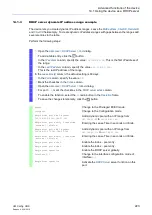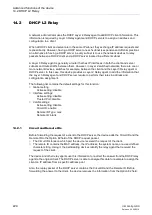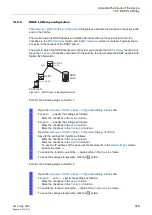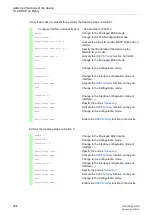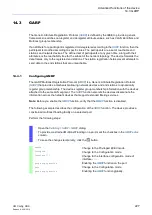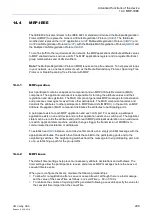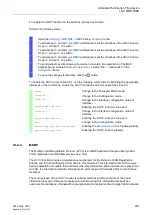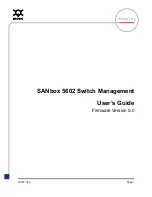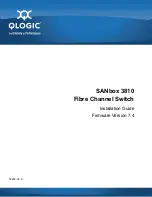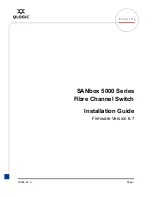
Advanced functions of the device
14.4
MRP-IEEE
230
UM Config GRS
Release
8.0
09/2019
The following list contains various MRP events that the device transmits:
Join - Controls the interval for the next Join message transmission
Leave - Controls the length of time that a switch waits in the Leave state before changing to the
withdraw state
LeaveAll - Controls the frequency with which the switch generates LeaveAll messages
When expired, the Periodic timer initiates a Join request MRP message that the switch sends to
participants on the LAN. The switches use this message to help prevent unnecessary withdraws.
14.4.3
MMRP
When a device receives Broadcast, Multicast or unknown traffic on a port, the device floods the
traffic to the other ports. This process causes unnecessary use of bandwidth on the LAN.
The Multiple MAC Registration Protocol (
MMRP
) lets you control the traffic flooding by distributing
an attribute declaration to participants on a LAN. The attribute values that the MAD component
encodes and transmits on the LAN in MRP messages are Group service requirement information
and 48-bit MAC addresses.
The switch stores the attributes in a filtering database as MAC address registration entries. The
forwarding process uses the filtering database entries only to transmit data through those ports
necessary to reach Group member LANs.
Switches facilitate the group distribution mechanisms based on the Open Host Group concept,
receiving packets on the active ports and forwarding only to ports with group members. This way,
any
MMRP
participants requiring packets transmitted to a particular group or groups, requests
membership in the group. MAC service users send packets to a particular group from anywhere on
the LAN. A group receives these packets on the LANs attached to registered
MMRP
participants.
MMRP
and the MAC Address Registration Entries thus restrict the packets to required segments of
a loop-free LAN.
In order to maintain the registration and deregistration state and to receive traffic, a port declares
interest periodically. Every device on a LAN with the
MMRP
function enabled maintains a filtering
database and forwards traffic having the group MAC addresses to listed participants.
MMRP example
In this example, Host A intends to listen to traffic destined to group G1. Switch A processes the
MMRP
Join request received from host A and sends the request to both of the neighboring switches.
The devices on the LAN now recognize that there is a host interested in receiving traffic destined
for group G1. When Host B starts transmitting data destined for group G1, the data flows on the
path of registrations and Host A receives it.
Figure 50:
MMRP
Network for MAC address Registration
Host A
Host B
Switch 1
Switch 3
Switch 2
MMRP Join G1 Request
Multicast Traffic for G1
Port 1
Port 2
Port 3
Port 4
Port 5
Port 6
Summary of Contents for GREYHOUND GRS1020
Page 8: ......
Page 16: ......
Page 146: ......
Page 232: ......
Page 310: ......
Page 330: ......
Page 338: ...Readers Comments 337 RM GUI GRS Release 8 0 09 2019 ...
Page 339: ......
Page 340: ......
Page 350: ......
Page 354: ......
Page 617: ...Readers Comments 277 UM Config GRS Release 8 0 09 2019 ...
Page 618: ......
Page 619: ......








